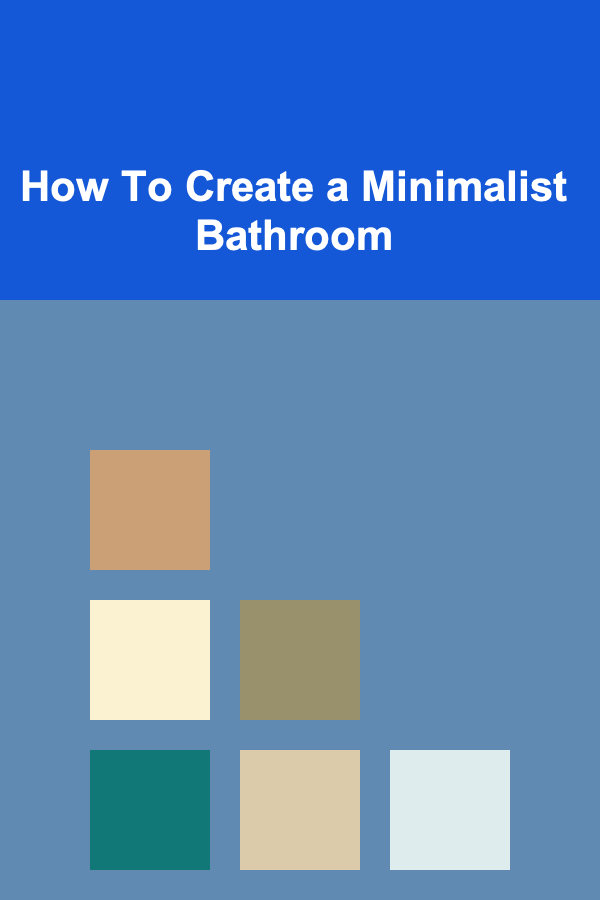
How To Create a Minimalist Bathroom
ebook include PDF & Audio bundle (Micro Guide)
$12.99$8.99
Limited Time Offer! Order within the next:

Creating a minimalist bathroom goes beyond just reducing clutter. It's about designing a space that feels open, serene, and purposeful while offering the essentials that enhance your daily routine. A minimalist bathroom combines style, function, and a sense of calm, making it a perfect escape from the hustle and bustle of daily life. In this article, we'll explore the key elements that define minimalist bathroom design and how you can apply them to your own space.
Understanding Minimalism in Bathroom Design
Minimalism as a design philosophy is all about "less is more." The goal is to create a space that feels both functional and aesthetically pleasing without unnecessary distractions. In the context of a bathroom, this means removing excess decor, limiting color palettes, and focusing on simplicity while ensuring that every element serves a purpose.
A minimalist bathroom typically features clean lines, neutral colors, and natural materials. Storage is often integrated seamlessly into the design to maintain an uncluttered feel. At its core, minimalist bathroom design aims to create a calm and efficient space that is easy to navigate and maintain.
Key Elements of Minimalist Bathroom Design
1. Simplified Color Palette
A minimalist bathroom design thrives on simplicity, and color plays a significant role in this. Neutral colors like white, gray, beige, and soft pastels are often the primary choices for walls, floors, and fixtures. These colors create a sense of openness and tranquility, which is crucial for a space that should feel peaceful and calm.
If you want to add a bit of personality, consider using one or two accent colors, but keep them subtle and natural. Soft greens, muted blues, or earthy tones like terracotta can work well without overwhelming the senses.
2. Focus on Functionality
In minimalist design, every piece must serve a functional purpose. This applies to bathroom fixtures, furniture, and accessories. For example, opt for a modern floating vanity instead of a bulky cabinet. This design allows for more floor space, creating an open and airy feel.
In terms of fixtures, choose sleek, streamlined designs that don't call attention to themselves. A wall-mounted faucet, for instance, helps reduce visual clutter. Toilets with concealed tanks are another great option as they contribute to a cleaner, more modern aesthetic.
3. Use of Natural Materials
Minimalist design often favors natural materials because they add texture and warmth to an otherwise clean and simple space. Stone, wood, and concrete are all excellent materials to incorporate into a minimalist bathroom.
Consider a stone countertop for the vanity or a wooden shelf for added storage. Wood, in particular, can be used to bring a touch of nature into the space, which can help to balance the coolness of other materials like metal or glass. If wood is not practical due to the moisture in the bathroom, consider using a wood-look ceramic tile or laminate for durability.
4. Open Shelving and Concealed Storage
Storage in a minimalist bathroom should be both functional and unobtrusive. Open shelving can work well for frequently used items, but too much open storage can contribute to visual clutter. Therefore, integrate storage that is hidden or built into the structure to maintain the clean lines of the design.
For example, a built-in medicine cabinet with a mirrored door can serve dual purposes of storage and reflection, contributing to the bathroom's sense of space. Another option is using floating shelves, which allow for visual lightness while still providing ample storage space.
When you do incorporate storage, think about how each item will be organized. Keep only the essentials on hand and consider storage solutions like baskets or trays to keep smaller items organized and out of sight.
5. Maximizing Light and Space
A minimalist bathroom should feel bright and open, so maximizing natural light is key. If possible, incorporate large windows or even a skylight to bring in as much light as possible. Natural light not only makes the space feel larger but also contributes to the sense of calm that is central to minimalist design.
If natural light is limited, consider using bright artificial lighting with dimming capabilities. LED lighting with a warm hue can create a soft, welcoming ambiance. Additionally, mirrors can be used to reflect light and visually expand the space, helping to create the illusion of a larger bathroom.
6. Streamlined Fixtures and Accessories
When it comes to fixtures and accessories in a minimalist bathroom, the key is simplicity. Choose modern, sleek designs that don't overwhelm the space. For example, opt for a simple, wall-mounted showerhead instead of a large, bulky one. Similarly, choose a sleek towel rack or a heated towel bar that blends into the walls.
As for accessories, less is more. Instead of multiple decorative pieces, select one or two items that add a touch of personality, such as a minimalist plant in a simple pot or a single piece of artwork. Avoid overcrowding the space with items that don't contribute to the overall function or aesthetic.
7. The Right Flooring
The flooring in a minimalist bathroom should complement the rest of the design. Neutral-colored tiles, such as large-format porcelain or ceramic tiles, are an excellent option as they create a clean, uninterrupted surface. If you prefer a bit of texture, consider adding natural stone tiles like marble or slate.
For an even more streamlined look, choose flooring that blends seamlessly with the rest of the bathroom. For example, the same tile material used on the floor can be extended onto the walls in the shower area, creating a cohesive design that feels open and uncluttered.
8. Incorporate Smart Technology
Integrating smart technology into your minimalist bathroom is an excellent way to maintain efficiency while reducing visual clutter. Smart showers with temperature control, touchless faucets, and motion-sensor lighting can all add convenience without compromising on style.
For example, consider installing a smart mirror with built-in LED lights and defogging capabilities. This keeps your space streamlined while adding functionality. Additionally, smart toilets with features like bidets or self-cleaning functions contribute to a more hygienic and efficient space.
9. Create a Spa-like Atmosphere
One of the key aspects of minimalist bathroom design is creating a space that feels relaxing and soothing. Incorporate elements that promote relaxation, such as soft lighting, calming scents, and plush towels.
Consider adding a bathtub with clean lines, perhaps a freestanding tub if your space allows. Surround the tub with natural stone or wood elements to create a spa-like atmosphere. A simple, clean shower area with a glass partition can also help maintain the serene feeling of the space while providing functional elements.
10. Keep the Space Clutter-Free
The most important element in a minimalist bathroom is the lack of clutter. Minimalism thrives on a sense of openness, and this is impossible to achieve if the space is filled with unnecessary items.
Take time to regularly declutter your bathroom and keep only the items that you need or truly love. Store extra toiletries out of sight, and keep countertops free from excessive products. A tidy, well-organized bathroom will instantly feel more minimalist.
Step-by-Step Guide to Creating Your Minimalist Bathroom
Step 1: Plan Your Space
Before making any decisions, assess the size and layout of your bathroom. Make sure to consider the placement of fixtures like the toilet, sink, and shower or bathtub. Think about the flow of the space and how you use it. Do you need a bathtub or would a shower suffice? Are there storage areas that could be maximized to minimize clutter?
Step 2: Choose the Right Color Scheme
Once you have your layout planned, choose your color palette. Stick to neutral tones like whites, grays, or beige for walls, floors, and fixtures. If you want to add a pop of color, keep it subtle and natural.
Step 3: Select Fixtures and Materials
Choose minimalist fixtures that contribute to the sleek, clean aesthetic you're aiming for. Select modern, functional pieces that have a simple design. Incorporate natural materials like wood, stone, and glass where appropriate.
Step 4: Add Subtle Accessories
Once you have the larger elements in place, consider the accessories. Keep them to a minimum, selecting only a few pieces that complement the overall design. A potted plant, a towel rack, and a simple mirror are often all you need.
Step 5: Organize and Declutter
The final step is organizing your bathroom. Remove any unnecessary items and ensure everything has its place. Invest in hidden storage solutions to keep the space tidy and functional.
Conclusion
Creating a minimalist bathroom is about simplifying your space to enhance both its function and aesthetic appeal. By focusing on clean lines, neutral colors, natural materials, and efficient storage, you can transform your bathroom into a serene, efficient, and beautiful space. Through thoughtful design choices and mindful organization, you can create a bathroom that serves as a peaceful retreat, offering both comfort and tranquility in the simplest of forms.
Reading More From Our Other Websites
- [Home Security 101] How to Develop a Home Emergency Plan
- [Home Rental Property 101] How to Create a Budget for Moving into New Apartments for Rent
- [Organization Tip 101] How to Organize a Kids' Closet for Easy Access
- [Organization Tip 101] How to Use Bins and Baskets for Easy Toy Cleanup
- [Home Pet Care 101] How to Recognize and Treat Common Pet Infections at Home
- [Scrapbooking Tip 101] From "Yes" to "I Do": A Step-by-Step Guide to Crafting the Perfect Wedding Scrapbook
- [Organization Tip 101] How to Prevent Future Wood Rot with the Right Repair Products
- [Organization Tip 101] How to Choose the Right Containers for Meal Prep Storage
- [Personal Care Tips 101] How to Use a Foam Roller to Relieve Muscle Tension and Improve Flexibility
- [Organization Tip 101] How to Use Baskets for Organizing Snacks in the Pantry

How to Create Profitable AI Solutions Using Deep Learning
Read More
How to Discover Series with Captivating Plot Twists
Read More
How to Establish a Morning Routine that Keeps You Organized
Read More
How to Make Your Home Feel Like a Retreat with Soft Lighting
Read More
How to Stage a Kitchen to Appeal to Buyers
Read More
How To Play Games to Learn a Language
Read MoreOther Products

How to Create Profitable AI Solutions Using Deep Learning
Read More
How to Discover Series with Captivating Plot Twists
Read More
How to Establish a Morning Routine that Keeps You Organized
Read More
How to Make Your Home Feel Like a Retreat with Soft Lighting
Read More
How to Stage a Kitchen to Appeal to Buyers
Read More